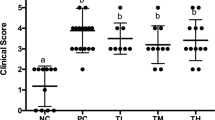Abstract
Balb/c mice fed 0 mg, 20 mg of β-carotene (BC) or 50 mg of vitamin E (Vit E) per Kg of diet for 7 weeks were immunized intraperitoneally with β-Lactoglobulin (β-Lg). Specific IgG and IgE anti β-Lg were determined in the mouse sera by an enzyme-linked immunosorbent assay (ELISA), and the jejunum was used for assessment of local anaphylactic responses ex vivo in Ussing chambers. Short-circuit current (Isc), a measure of active ion transport, and epithelial conductance (G), a measure of passive ion permeability, were measured for each tissue. Specimens were also processed for examination by histological analysis. Compared with sensitized mice (unsupplemented mice), those fed BC or Vit E had lower β-Lg-specific IgG (p < 0.001 and p < 0.0001, respectively) and IgE levels (p < 0.02 and p < 0.01, respectively). A secretory response reflecting local intestinal anaphylaxis was evident in sensitized mice, as indicated by an increase in Isc (p < 0.009). Sensitized mice demonstrated also an enhanced epithelial permeability as measured by conductance (p < 0.03). BC supplementation resulted in a significant decrease in secretory response (p < 0.02) with no effect on the epithelial permeability. Interestingly, the secretory response and epithelial permeability were significantly reduced by supplementation with Vit E (p < 0.02 and p < 0.009, respectively). These findings provide evidence for the first time that both BC and Vit E regulate epithelial ion transport, but it should be noted that only Vit E-supplemented mice showed a decreased tissue conductance, indicating protection from β-Lg-induced epithelial permeability increase. Analysis of histological sections revealed that BC or Vit E treatment clearly reduced the microscopic lesions caused by β-Lg sensitization.





Similar content being viewed by others
References
Yang PC, Berin MC, Yu LCH, Conrad DH, Perdue MH (2000) J Clin Investig 106:879–886
Strobel S, Mowat AM (1998) Immunol Today 19:173–181
Falth-Magnusson K, Kjellman NIM, Odelram H, Sundqvist T, Magnusson KE (1986) Clin Allergy 16:543–551
Jalonen T (1991) J Allergy Clin Immunol 88:737–742
Troncone R, Caputo N, Florio G, Finelli E (1994) Allergy 49:142–146
Yu LCH, Perdue MH (2001) Immunol Rev 179:61–73
Chandra RK (1997) Am J Clin Nutr 66:460–463
Sato Y, Akiyama H, Suganuma H, Watanabe T, Nagaoka MH, Inakuma T, Goda Y, Maitani T (2004) Biol Pharm Bull 27:978–984
Sato Y, Hiroshi A, Hideki M, Kozue S, Rika N, Shingo I, Takahiro I, Mamoru Y, Motohiro E, Reiko T (2010) J Agric Food Chem 58:7180–7186
Okamoto N, Murata T, Tamai H, Tanaka H, Nagai H (2006) Int Arch Allergy Immunol 80:141–172
Moriguchi S, Muraga M (2000) Vitam Horm 59:305–336
Bando N, Yamanichi R, Terao J (2003) Biosci Biotechnol Biochem 10:2176–2182
Negaoui H, Kaddouri H, Kheroua O, Saidi D (2009) Am J Immunol 2:56–60
Zellal D, Kaddouri H, Grar H, Belarbi H, Kheroua O, Saidi D (2011) Food Agric Immunol 22:355–363
Grar H, Kaddouri H, Gourine H, Negaoui H, Kheroua O, Saidi D (2009) Eur Food Res Technol 229:779–783
Monaci L, Tregoat V, Arjon J, Hengel V, Anklam E (2006) Eur Food Res Technol 223(149):179
Chen SS, Gong J, Liu FT, Mohammed U (2000) Immunology 100:471–480
Sakai S, Sugawara T, Matsubara K, Hirata T (2009) J Biol Chem 284:28172–28179
Manabe Y, Hirata T, Sugawara T (2014) J Oleo Sci 3:291–294
Whitekus MJ, Zhang M, Wang M, Horwitz MA, Nelson SK, Horwitz LZ, Brechun N, Diaz-Sanchez D, Nel AE (2002) J Immunol 168:2560–2567
Ray S, Watkins DN, Misso NLA, Thompson PJ (2002) Clin Exp Allergy 32:571–577
Saïdi D, Heyman M, Kheroua O, Boudraa G, Bylsma P, Kerroucha R, Chekroun A, Maragi JA, Touhami M, Desjeux JF (1995) CR Acad Sci III 318:683–690
Addou-Benounane S, Tome D, Kheroua O, Saidi D (2004) Int Immunopharmacol 4:1559–1563
El Mecherfi KE, Rouaud O, Curet S, Negaoui H, Chobert JM, Kheroua O, Saidi D, Haertlé T (2015) Int J Food Sci Technol 50:356–364
Hagenlocher Y, Lorentz A (2015) Mol Immunol 63:25–31
Crowe SE, Perdue MH (1992) Gastroenterology 103:1075–1095
Benjamin MA, McKay DM, Yang PC, Cameron H, Perdue MH (2000) Gut 47:112–119
Elli M, Aydin O, Bilge S, Bozkurt A, Dagdemir A, Pinarli FG, Acar S (2009) Tumori 95:87–90
Gheibi S, Karimipour M, Mahmoodzadeh R, Nargesi AA, Salabati M (2013) Pharm Sci 19:83–90
Acknowledgments
This research was supported by the Directorate General for Scientific Research and Technological Development (DGRSDT, MESRS, Algeria). The authors would like to thank Mr. Thierno Aliou Diallo for accepting to read our article.
Conflict of interest
The author confirms that this article content has no conflict of interest.
Compliance with Ethics Requirements
The experiments described in this study comply with the current Algerian legislation covering the protection of animals.
Author information
Authors and Affiliations
Corresponding author
Rights and permissions
About this article
Cite this article
Grar, H., Dib, W., El Mecherfi, K.E. et al. Supplementation with β-carotene or vitamin E protects against increase in anaphylactic response in β-lactoglobulin-sensitized Balb/c mice: ex vivo study. Eur Food Res Technol 241, 393–398 (2015). https://doi.org/10.1007/s00217-015-2471-5
Received:
Revised:
Accepted:
Published:
Issue Date:
DOI: https://doi.org/10.1007/s00217-015-2471-5




